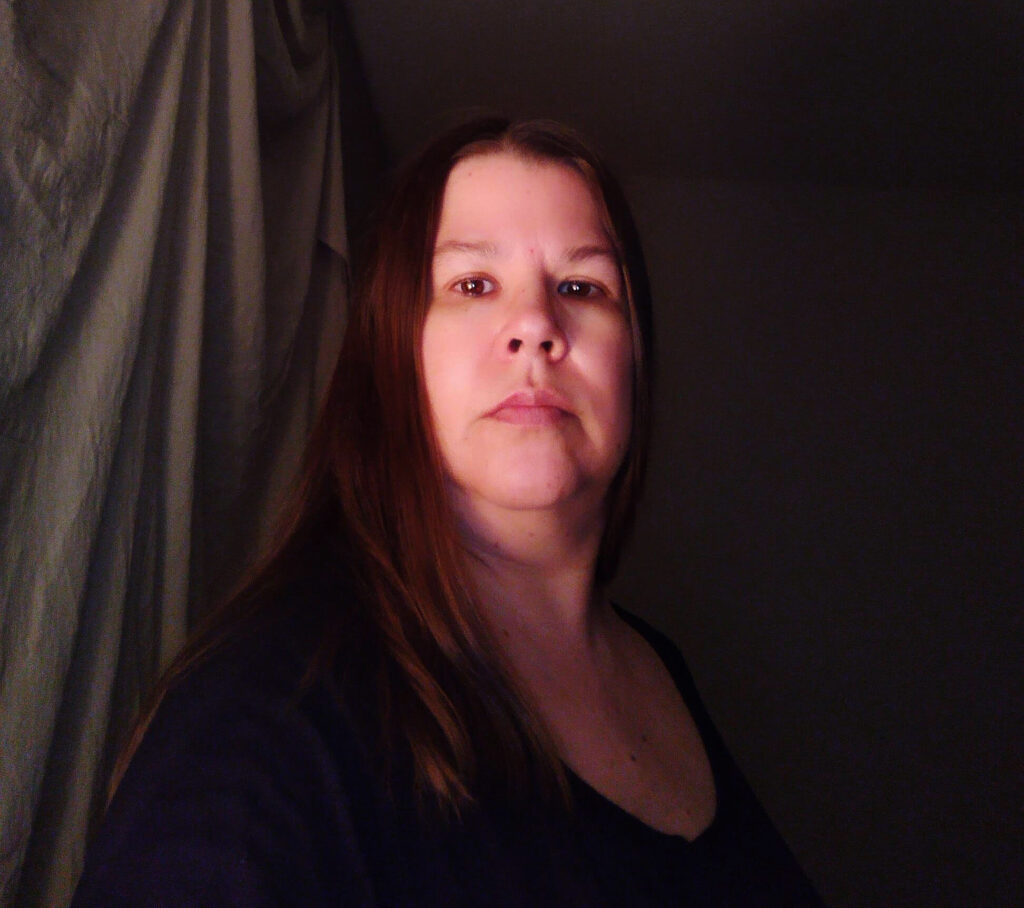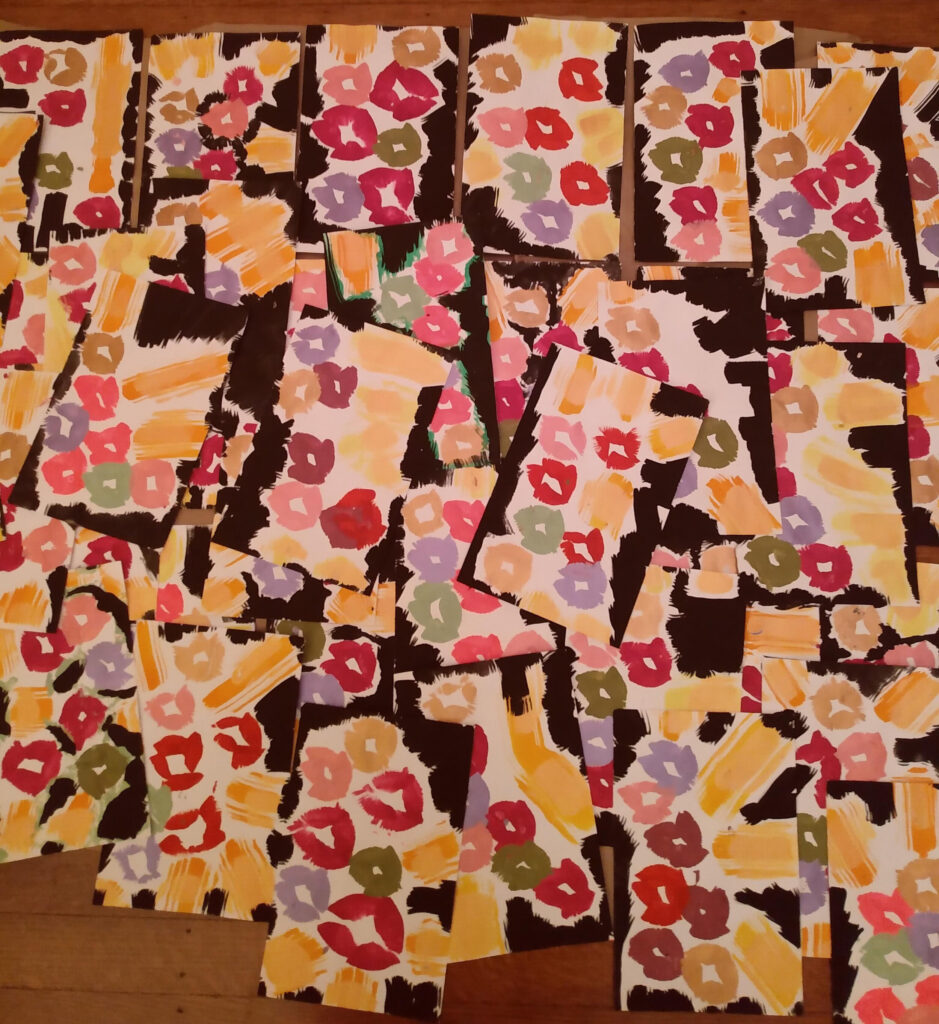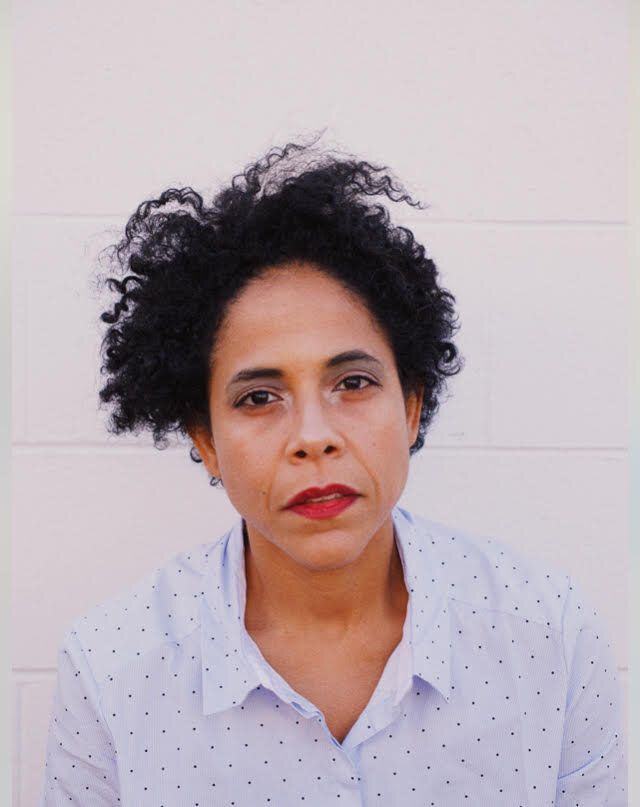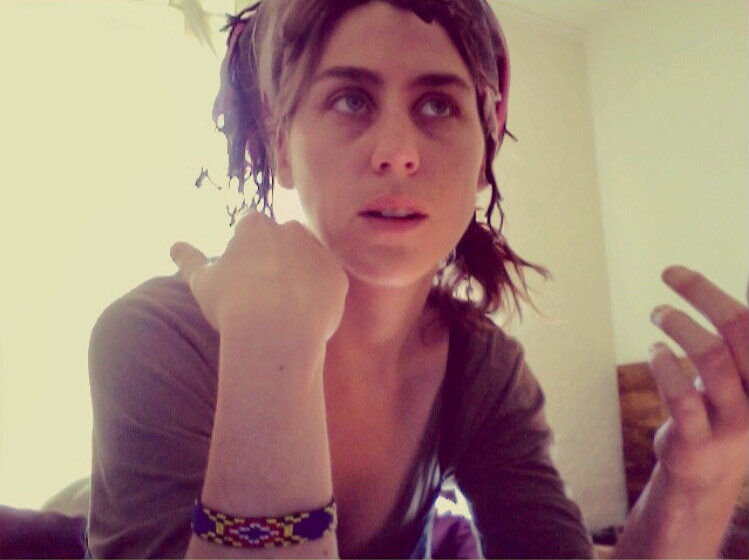
Christina Carter – I’ve used the same bio (more or less) for the past, I’m not sure, fifteen years. It’s time for a change. I grew up in Houston and lived there most of my life. I wanted to play music since I was a child but started and quit guitar lessons on the same day, during the lesson. I was 10 years old, or about that old. In high school I wrote stories about playing music. And started playing music for real as Charalambides in 1991 with Tom Carter (and Kyle Silfer). I started playing solo too in 1999. This is a simplified timeline.
I take long breaks from doing music that don’t seem like breaks to me. They are breaks from the physical part of it but not the mental or emotional part. For example, I haven’t recorded a note since 2017 when Tom and I recorded the last Charalambides album. But it doesn’t matter in a way. It is what I want sometimes. But sometimes it isn’t. And sometimes I was playing live during that time. My plan for 2020 was to play one show every month. Playing live used to be the thing I often dreaded. Then it became exciting and felt real most of the time. Before it felt heavy and surreal a lot of the time. I mean stressful and forced. I’m not sure what it is going to be like when I can play again in the same place with people. In my imagination it will be different again and feel different again. The point is I feel like my music is me and I am my music.
COTFG – What are some influences on your recent work? Musical or otherwise?
Christina Carter – It’s hard to talk about influences over a 30-year time period or from the perspective of looking back to the beginning of listening, almost 50 years now. And I’ve already talked about so many of these great artists before that inspire me like Patty Waters, Sarah Vaughan, June Christy, Tim Buckley, Sandy Denny, Julie Driscoll /Tippetts, Linda Sharrock. And about poets like Kenneth Patchen. And high school years listening to Joy DIvision and New Order and reading Anne Sexton, Sylvia Plath and Baudelaire. No one mentions Anne Sexton anymore. Peter Laughner has those two amazing songs about Baudelaire and Sylvia Plath. I wonder what kind of difference that would have made if I could have heard those songs earlier. It’s like Bob Dylan. I started listening to him because he did “House of the Rising Sun” ha ha! That song makes me feel strange. Things influence me that make me feel strange. Elated. Hearing something distant yet familiar. Or just so gorgeous and evident – once you hear it. John Coltrane. But listening is only part of it in the long run. The other part is immediate, personal experience. The biggest influence, of course, is Tom because he and I together could do something. There’s a lot of other people that were direct influences like that, but not quite like that. I’ve never known how to answer this question adequately. A lot of people get left out. It’s a totally incomplete picture that doesn’t do it justice. I mean there’s so much. Just lately a high school acquaintance came to mind. She was really friends with my step-sister but we all rode the bus together. Kathryn. She told me about recording her own songs on a cassette player. I asked her how she did it. What about instruments? She said she just sang her songs into the built-in microphone, just voice. And she told me about the 13th Floor Elevators and buying their albums at the record store in West Oaks Mall because of the psychedelic words and triangles on the cover. We were 14 and it was 1982 and we were on this horrible bus on our way to this horrible school and it was a glimpse of something else, something more. Escape. That concept was a big influence and for me escaping meant moving to Montrose, the place in Houston where all the people who wanted to escape narrow, straight life seemed to go. That place, made up of the people who came before me, helped me to find a way to be myself and express myself and figure out how to survive in an otherwise extremely inhospitable city. And I only had to move ten miles or so to get there. A long ten miles that took about ten years to cover. Or our first label, Siltbreeze. I was thinking about it recently and it occurred to me that not only did Siltbreeze put out our records and make it extremely easy for us to right away think in terms of maximum effect, double albums and the like, without any interference. They also embodied this example of going to the source – Columbus, Miami, Folkestone, Dunedin, Philadelphia, Houston, etc. – and paying attention to those who are doing it there and then, instead of waiting for approval and waiting for stuff to garner attention elsewhere. And so that set the tone for us right from the beginning of that feeling good and that feeling right and that defining what being involved in this world of music meant, and could ideally mean.
Allright fair enough, skip ahead a good 25 plus years and what are the influences? Texas Modern Exorcism (Many Breaths), my last full length solo release, had me thinking about lushness and beauty and fragility and corruption and cruelty, and terror, I guess. And what you can make of life in spite of, or because of, all of that. And feeling the decades of living through art, reflected in the song titles: Painting, Dance, Film, Poetry, Music, Drama. How there’s so much beauty in form and formless form. But also, this sense of the end started coming to me. I kept thinking about this quote from Ukrainian composer Valentyn Silvestrov, “It is very much in the area of the coda that immense life is possible.” Of course, Tom had just gotten sick and almost died in Berlin the year before. But there was more to it. The first song I know kept bringing up to me the (seemingly awful) movie Raintree County, a movie which I didn’t realize until then exacted any kind of long-term attention from me. But, not having seen it since I was a child even now, what it makes me think of is the sicknesses of the cultures that I grew up in within in the United States. At the same time there is all of this beauty within the art that people have made in attempts at protest against that sickness. It’s confusing and it seems as though there is no way to reconcile it. The lyrics on this album span the time I lived in Northampton, Massachusetts and there was a dimension of exorcising my growing up in Texas and having moved away and having come back. Sort of a summation of my life until the moment of beginning the recording. More, all this was joined to the feeling I started having that something fundamental on a larger level is failing. The coda isn’t just about my life or an era or even a country but something deeper. I mean, we are in the middle of the largest extinction event there ever was and possibly ever will be. Tom and Christina Carter (Drawing Room) is the culmination of this feeling, in a way. The overt lushness is stripped, but the attitude of lushness is still present. It is looking back on the inarticulate teenager that I was and that my birth parents were, grasping at the desperate hope in the realization that even though everything is fucked, you’ve decided that you have a right to exist in the middle of it. I was thinking about, really, I was feeling, the ocean and the railroad and the highway and the night and all of the foolish and romantic symbols of freedom that intrigued and enflamed and comforted me as a young woman. There are these memories of what used to be visceral sensations in a still living, but curling, drying structure of a song. It was improvised to ‘tape’, all live with no editing to speak of, outside of the most basic trimming of beginnings and endings. At first, we thought I’d lay some additional vocals on top, but that idea quickly got scrapped. The way I’m struggling for words and not finding them most of the time seemed correct. The vocal performance on the album is something I’m perplexed and mesmerized by, and I say that without vanity. The simultaneous beauty and… What is it? Because it’s not ugliness exactly,,, but ugliness is the closest word, fills me up with wonder, not being entirely sure how I did it. It’s those kinds of experiences I’m wanting to create in music. I’m hunting after. The details of the emotional life and its aftereffects. But in a manner in which I can still be an observer too, who is also listening from the outside, doubled.
What have you been listening to lately?
Right now, I’m listening to Loren Connors & Oren Ambarchi Leone (Family Vineyard). Last night, Pisaura Asteraceae (Sedimental). And I’ve been listening to my friend Julia’s radio show called The End of the World on 97.5 WLCI Hocking College Community Radio. A song she played that really surprised me was “Pretty and High” by The Roches. Another friend used to tell me about The Roches back in the late 80s and I was like, “Whatever, yawn.” I could be so dumb. Annoyingly so, since usually I am pretty open. Anyway, later tonight I’m going to listen to Tom’s new album, Beautiful Saviour that he self- released. Almost all last year, Beethoven string quartets, Giacinto Scelsi, Susan Alcorn, and Mauve Sideshow. Plus, I started listening to Jandek again, which I’d not done in quite a few years, so there’s a lot I haven’t heard.
You know, music isn’t something that’s just on all of the time. Relative silence is so tempting. Just getting into that zone of absence of sound as much as possible. I’ve lived so many noisy places, really disturbing sometimes. But also, due to the virus, I got laid off of the 40 hours-per-week at the record store gig. So then, it was great to get back into listening for my pleasure and contemplation only for an extended period of time in a way that hadn’t been possible for a long while. Nine hours of Beethoven in a day and then nine days of nothing. A lot of Helen Merrill. Not enough people talk about Helen Merrill. Jeanne Lee. Bill Nace’s latest, Both (Drag City). And Alice Coltrane Live at the Berkeley Community Theater really is one of the most mind-blowing documents I’ve ever heard. Writing about these albums is making me excited about listening to stuff. All kinds of favorites are jumping out of memory saying, “What about me?” Like I saw someone mention Yoko Ono the other day in a positive context without referencing the Beatles even and that was great. Finally, that doesn’t seem so absurd or unusual to be happening. And it made me want to listen to, like, Feeling the Space or something in honor of that space of ‘ordinary’ Yoko – ha ha. Jimmy Giuffre is calling my subconscious saying, “It’s been a while.” Thank goodness it’s bubbled up to conscious level. Call Back the Giants, Tim Goss from The Shadow Ring. I got reminded to listen to that by an interview with Graham Lambkin in Tone Glow, which as a publication has kind of restored a little bit of my… I don’t know, faith? Well, perhaps just enjoyment reading people talking about what music means to them without it being nailed down to some kind of sales pitch cycle. And just now Russell Oberlin, the countertenor, singing Purcell’s “Music for a while” seems like it would sound good. Which reminds me of Janet Baker singing Mahler’s “Der Abschied,” in a round-about way, which I’m listening to now. And finally, the other day “Eminence Front” by The Who came up and I watched the video and it made me think about Led Zeppelin and The Rolling Stones and their relative merits, boiling down to what a weird disjointed band The Who was in comparison to the other two. That song, though, is pretty interesting, “Eminence Front.” The whole vibe of masculinity and neverendingness reminded me of Jackson Pollock. Oh, one more, George Benson covering Leon Russell’s “This Masquerade.” This song made such a huge impression upon me as a child before I had any idea who Leon Russell was. (Now I’m listening to “Pretty and High.” Wow. Now “This Masquerade.” The Russell version. Wow.) I ended up buying an Ibanez George Benson model guitar in 1999 or so. You can see me playing it in this video of a live performance from 2008 that I just found out is on YouTube. It might be the longest video document of my playing ‘lead’ guitar. For some reason this show had to be a solo performance (with Tom sitting in) rather than a Charalambides performance, even though Charalambides was on tour. So, thanks to that, it’s also one of the only live performances of songs from my solo album Masque Femine that exists.
What other ways of expression do you hope to explore using recorded video or live streaming, if you are?
I started thinking about live streaming video around 10 years ago. Or recorded video. You know I didn’t know how to do it or how it would be done. It was just another phase of thinking about how doing art uses resources. I was already feeling uptight about making visual art with brand new supplies. But I never got anything together because I dislike fiddling with technology, machines. One reason why I switched to doing voice almost all of the time. I love guitars (the Instrument of the People!) but all of the stuff that goes along with it gets me down sometimes. Physical stuff: Carrying guitars, amps, fooling with knobs, tuning, strings, whatever. So how can I say I love guitars? I don’t know but I do. The guitar is the greatest instrument ever invented. (I’m trying to exaggerate but it comes close to my actual feeling. Drums I don’t consider invented. Flutes maybe too. Now there’s a debate.) Anyway, I was thinking about how I could do shows from where I was living and it would be so intimate and exact. There could be an atmosphere of privacy and memory. Like watching a film. But that’s pretty naive. Still, my plan is to try to make some films. Another plan is recording a piece for Longform Editions and then a cassette for Anahuac Editions. Longform Editions most people know, probably? I mean most people that are reading this. In case not, it’s a digital label releasing long-form sound works, songs, pieces of, usually, 20 minutes or longer in length. Anahuac Editions has been putting out cassettes and CDs for a while. Both labels are on Bandcamp. And I’ve been doing some watercolors. Coincidentally, Unifactor Tapes out of Cleveland also asked me for some cover art. For a while, visual art was the real pain in my neck. It was difficult to understand exactly how to go about doing it without an innate ability to draw. Like giving up the guitar lessons, early on there was frustration over trying to use oil pastels and some throwing-away-efforts-in-the-trash as a child. But it kind of continued to haunt me. My goal for a time in my late teens was to paint Virgin Marys, but that didn’t work out. Somehow flowers and these abstract washes in gauche started coming to me while making art to accompany music releases. A cherished memory is when I brought some of this art on tour for the first time to give away at one of the early shows Charalambides played after an extended break due to illness and moving and difficult circumstances all around really. It was at Byron Coley’s space dubbed the Yod Mill Outlet in Florence, Mass and he and Thurston Moore (and probably some other people) had asked us to open for Loren Connors. Naomi Yang was there and she was enthusiastic about these little watercolors. She told me they reminded her of William Baziotes whom I’d never heard of at the time. And that meant so much to me. One of the reasons for conceiving of even bringing them on tour was John Fahey. When he started touring again in the latish 90s, he was doing these small paintings in hotel rooms before the shows and selling them for five bucks each (!). I bought a few and, staring at them I thought, “Oh, I get it. He’s not thinking about ‘art’. He’s thinking about making gestures, which makes art. And I can do that too.” So, if it wasn’t for John Fahey and Byron and the Massachusetts contingent and Loren agreeing to play with us on that particular show, who knows what I would be doing now. These are the people and situations that help you feel the yes in the world. Be those kinds of people, people. The kinds of people that help people find their yes. But the films. It was my hope to finish one for this interview, which didn’t work out. They’ve got to be magical in my eyes and that’s all I can say about that.

What does “avant-garde” or “experimental” mean to you?”
The first thing that occurs to me is that there’s two basic ways of thinking about it. The first involves what the definitions of those terms mean as far as trying to support, curate, book, sell, document, and understand that broad realm of music in organizational terms. I’m not going to deny that those terms are impactful and meaningful in some ways in the musical landscape we have now in a competitive capitalist cultural system. And it’s necessary for people to understand that categorization is probably not going away anytime soon. And that, regardless, musics that currently fit the broad agreed upon, though contested, conception of these categories do require championing as such. Collapsing everything into even broader categories, I don’t know what – sellable or unsellable? interesting or not interesting? relevant or not relevant? timely or not timely? – doesn’t seem to be an improvement to me because the more effective marketing machines still are going to win and in essence define those categories too. So, I do think that a commitment to experimental and avant-garde aesthetics, philosophies, practices is important as far as that goes. Stand for something in other words. And that something is that not everyone is down with being primarily a commodity who is just operating with a wink and a nudge.
The second thing that occurs to me on a personal level, from the inside of doing music and art, is that these terms are less relevant to me in as much as I do or don’t consciously or intellectually proscribe for myself certain aesthetics in advance. Where the ideas of experimental and avant-garde seem to arise for me is within a more psycho-spiritual realm of desire. That’s where I consciously prescribe for myself a certain attitude in advance and a certain relationship with making art. So, to me, everyone has their own songs inside of them and the purpose of what is called art, or more broadly human culture, is to search for that music within, bring it out, and share it with others. It’s about psychological and spiritual risk-taking and courage to show your presence. Being driven to locate what you is to you, your sound, your resonancing, and give that to others. “The Song Is You” goes like this: “I hear music when I look at you, a beautiful theme of every dream I ever knew. Down deep in my heart I hear it play; I feel it start, then melt away. I hear music when I touch your hand; a beautiful melody from some enchanted land. Down deep in my heart, I hear it say, Is this the day? I alone have heard this lovely strain; I alone have heard this glad refrain: Must it be forever inside of me? Why can’t I let it go? Why can’t I let you know, why can’t I let you know the song my heart would sing? That beautiful rhapsody of love and youth and spring, the music is sweet, the words are true — the song is you.” That’s Jerome Kern. And as “There Will Never Be Another You” says: “Yes, I may dream a million dreams, but how can they come true If there will never ever be another you?” That’s Mack Gordon. It’s enchantment, mystery, fascination, ecstasy, communion, daring, courage, love, delight, surprise, longing, letting go. For me, there has got to be an element of going to the root of these feelings in the here and now. For me, there’s an element of not wanting to repeat the moment but being compelled to search for echoes of it in the now. For me, there’s an element of welcoming failure. For me, there’s an element of accepting pain. Love is attached to pain, to all of these states. To not being afraid of showing the entire range of human emotions in the possibility of song. The sounds that make the most sense to me in this context, a lot of the time anyway, are ones that are called experimental and/or avant-garde by people. But it should be clear that I’ve not got much in common with anyone who says that the goal of this music is to remove the ego, narrative, self-expression, or anything like that from the music. Why anyone would want to eliminate human self-expression from this music baffles me. How does anyone think they possibly could?
You can find out more about Christina Carter’s work at :
charalambides.bandcamp.com
christinacarter.bandcamp.com
Links by COTFG


